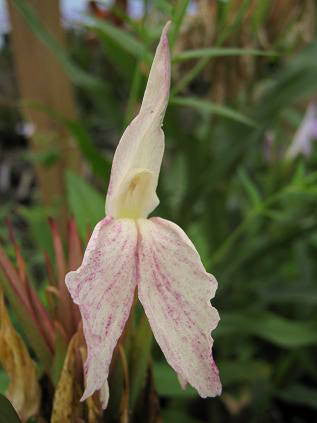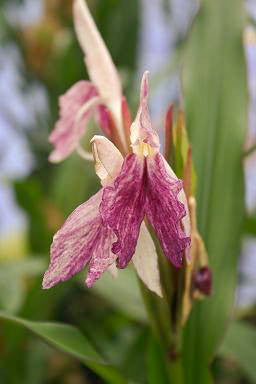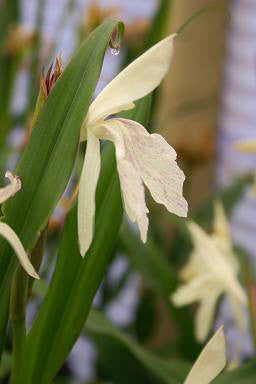Roscoea x beesiana
Approx. 0.5 litre pot
About this cultivar:
Roscoea x beesiana was given the Award of Garden Merit by the Royal Horticultural Society in 2011. Why? Because it is a fantastic performer! Worthy of any garden!
It is considered to be a hybrid between R. auriculata and R. cautleyoides, but its precise origin is unknown. The epithet beesiana is derived from a plant nursery in England called Bees Ltd, founded by Arthur K. Bulley, well known as a plant enthusiast in the late 19th and early 20th century. However there is no evidence that the hybrid occurred there; the first mention of the name is in 1970, "long after the heyday" of the nursery. The name was not formally published until 2009, when Jill Cowley and Christopher Whitehouse provided a description and Latin diagnosis. It has also been known under the cultivar name Roscoea 'Beesiana', an invalid name under the International Code of Nomenclature for Cultivated Plants, which does not allow Latin words as cultivar names after 1958.
R. x beesiana differs from its putative parents in flower colour and in several other ways. It has a more deeply divided labellum than R. auriculata, whose labellum is either unlobed or lobed to less than half its length. Unlike R. cautleyoides, it has leaves with small "ears" at the junction of the blade and sheath and larger bracts, over rather than under 6 cm long.
The flowers are HIGHLY variable – the plant you order may differ greatly from the photos you see! Most forms have a pale cream base colour with varying amounts of purple streaking, particularly on the lip or labellum.
- Position: Full sun, partial shade
- Soil: Almost any soil, grows well in Ballyrobert
- Flowers: July, August, September
- Other features: --
- Hardiness: Fully hardy, grows well in Ballyrobert
- Habit: Columnar or Upright, clump forming
- Foliage: Deciduous
- Height: 30 - 45 cm (1 - 1.5 ft)
- Spread: 15 - 45 cm (0.5 - 1.5 ft)
- Time to full growth: 2 to 5 years
- Plant type: Herbaceous Perennial
- Colour: Green, pink, yellow
- Goes well with: --
About this genus:
Roscoea is a genus of perennial plants of the ginger family (Zingiberaceae). Most members of the family are tropical, whereas Roscoea species are native to mountainous regions of the Himalayas, China and its southern neighbours. Roscoea was named by the English botanist James Edward Smith in 1806. The name honours Smith's friend William Roscoe, the founder of the Liverpool Botanic Garden (remnants of which can now be found at Croxteth Hall).
These rather exotic-looking plants look like irises to some and orchids to others. Their appearance seems to suggest a lack of hardiness to gardeners, however these tuberous, rooted plants are hardy if planted deeply. There are up to 17 species in all and eight are found in China. They are prompted into growth at the start of the monsoon season, emerging later than most plants, so they enjoy late-spring and early-summer rain but actively resent dry weather and scorching sun; not problem on these islands!
Roscoeas form tuberous roots that resemble small dahlia tubers. These push downwards to form vertical roots in the soil, before dying back in winter to leave a gap. These tubers are very vulnerable if left in a pot during winter, so if you buy a roscoea do plant it as soon as possible and as deeply as you can. Otherwise you may lose your plant.
The stems of roscoeas are formed from tightly wrapped leaves and these can colour up in some cases. The flowers are long-lasting in shadier positions, giving four to six weeks of interest. The flowers of most can shrivel in hot sun, so site them carefully.
They are extremely useful in woodland gardens, grown in light shade, as they perform after most woodlanders and extend the flowering season. They associate well with spring woodlanders, bulbs and ferns in the dappled shade provided by deciduous trees and shrubs. Other shorter forms, found naturally on screes in the wild, are perfect for the alpine slope in sunnier situations. So you do need to select your varieties and forms. Good winter drainage is essential for both types, but alpine screes and woodland gardens tend to have good drainage. They prefer semi-shade but will tolerate a sunny position if plenty of moisture is present during the summer. Avoid deep shade which will draw the plants up, making them floppy, and reduce leaf colour.
But don't worry too much, we grow a few of ours close to the edge of a border to 'suprise' people walking by!








